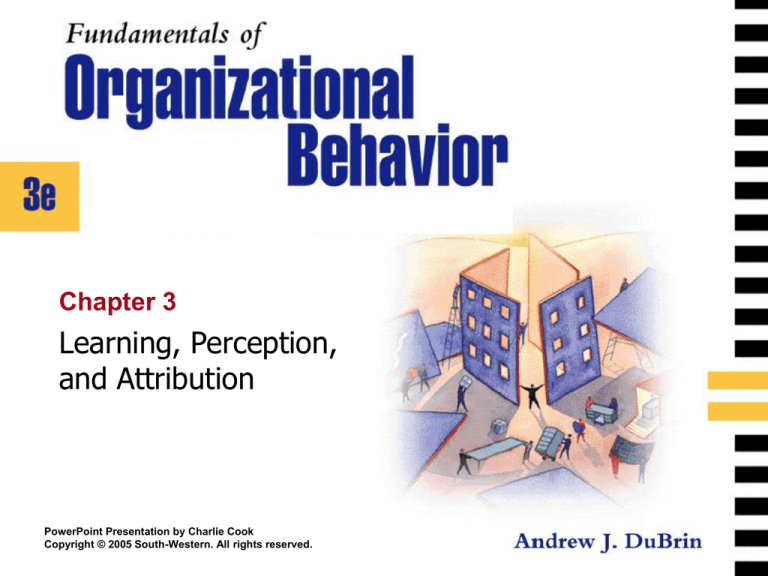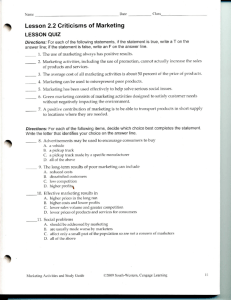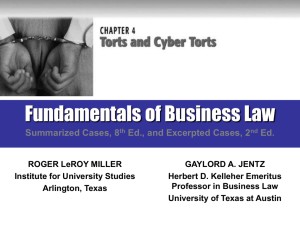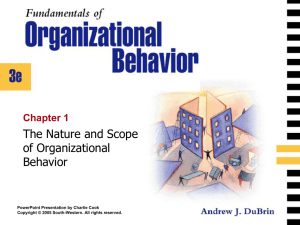
Chapter 3
Learning, Perception,
and Attribution
PowerPoint Presentation by Charlie Cook
Copyright © 2005 South-Western. All rights reserved.
Learning Objectives
After reading and studying this chapter and doing the
exercises, you should be able to:
1. Explain the basics of modeling and shaping, cognitive
learning, and e-learning.
2. Describe how learning styles influence workplace learning.
3. Describe key aspects of the perceptual process, along with
common perceptual problems.
4. Describe how attribution theory contributes to an
understanding of human behavior in the workplace.
Copyright © 2005 South-Western. All rights reserved.
3–2
Learning
• A relatively permanent change in behavior
based on practice or experience.
Is beyond innate inborn patterns of behavior.
Is necessary for satisfactory job performance.
Copyright © 2005 South-Western. All rights reserved.
3–3
Modeling and Shaping
• Modeling (or imitation)
Occurs when a skill is learned by observing another
person performing that skill.
Requires careful observation followed shortly
thereafter by use of the newly acquired skill.
Elicits new behaviors in motivated capable learners.
Copyright © 2005 South-Western. All rights reserved.
3–4
Modeling and Shaping (cont’d)
• Shaping
Learning through the positive reinforcement or
rewarding of small steps that build to the final or
desired behavior.
Copyright © 2005 South-Western. All rights reserved.
3–5
Cognitive Learning
• Cognitive learning theory
Learning is a complicated process in which reasoning
and analytical skills are used in acquiring knowledge.
• Informal learning
Learning that is not determined or designed by the
organization. It can be divided into four categories:
Practical
skills
Intrapersonal
skills
Interpersonal
skills
Cultural
awareness
Copyright © 2005 South-Western. All rights reserved.
3–6
E-Learning
• Aspects of e-learning
Web-based computer training that is carefully
structured, specific lessons plans for an individual
student
Learner motivation and participation are enhanced
through reinforcement by managers.
Success in completing online courses is dependent
upon individual self-motivation and self-discipline.
Practice
Effort
Copyright © 2005 South-Western. All rights reserved.
3–7
Learning Styles
• Concepts of learning style
People learn best in different ways.
Certain
material is best mastered in certain ways
(e.g., learning to swim by practicing in a pool).
Some people learn best alone, others in groups
(cooperative learning).
Learning is a continuous process controlled and
directed by an individual’s internal needs and goals.
Copyright © 2005 South-Western. All rights reserved.
3–8
Learning Styles (cont’d)
• Four modes (stages) of learning styles:
Concrete experience
Reflective observation
Abstract conceptualization
Active experimentation
Copyright © 2005 South-Western. All rights reserved.
3–9
Perception
• Perception
Deals with the ways in which people interpret things
and how they act on the basis of these perceptions.
Has important effects on job satisfaction
and motivation which, in turn, lead to better
job performance.
Copyright © 2005 South-Western. All rights reserved.
3–10
Perception (cont’d)
• Aspects of perception important
to managers:
Perceptual distortions and problems
How people attribute causes to events
Copyright © 2005 South-Western. All rights reserved.
3–11
Perceptual Distortions and Problems
• Characteristics of the stimulus
Having a strong interest (i.e., emotions, needs,
attitude, or motivation) in an issue tends to cause
misperceptions of a stimulus.
Actual
Less
Copyright © 2005 South-Western. All rights reserved.
Perceived
Interest
More
3–12
Mental Processing Shortcuts
• Denial—refusing to admit that the information even
exists.
• Stereotyping—reducing ego discomfort by evaluating
individuals on the basis of the group to which we
perceive that they should belong.
• Halo Effect—allowing one recognizable or unfavorable
trait to color all that we know about a person.
• Projection—projecting personal faults onto others and
not making an objective appraisal of the situation.
• Selective Perception—filtering out information with which
we do not agree.
Copyright © 2005 South-Western. All rights reserved.
3–13
Contributors to
Perceptual Distortions
“I’m a human with feelings.”
“Did you say that I get
an average performance
evaluation?”
Emotionally
Charged
Stimulus
Person as
Perceiver
Perceptual
Distortion
Mental Processes
Denial
Stereotyping
Halo effect
“I have to interpret this
message for myself.”
Projection
Selective perception
I think
“
I heard you say that
I’m better than most workers.”
EXHIBIT 3-1
Copyright © 2005 South-Western. All rights reserved.
3–14
Attribution Theory
• The process by which people ascribe causes to
the behavior they perceive.
Fundamental attribution error: the tendency to
attribute behavior to internal causes when focusing on
someone else’s behavior.
Self-serving bias: takes place when focusing on our
own behavior causes us to attribute our achievements
to good inner qualities and our failures to adverse
factors within the environment.
Copyright © 2005 South-Western. All rights reserved.
3–15
Attribution Theory (cont’d)
• People ascribe causes of behavior based on
information gathered on three dimensions:
Consensus—how similar is the person’s
behavior to the behavior of others on the
same task.
Distinctiveness—how much does the person’s
level of performance on the task at hand
differ from their performance on other tasks.
Consistency—how stable is the person’s level
of performance over time.
Copyright © 2005 South-Western. All rights reserved.
3–16
Kelley’s Theory of Attributing Causes—an Example
EXHIBIT 3-3
Copyright © 2005 South-Western. All rights reserved.
3–17
Locus of Control
• Internal locus of control
Persons who perceive themselves to be in control of
their lives; creating their own opportunities.
• External locus of control
Persons who believe that their lives are controlled by
circumstances and attribute their success or failure to
luck.
Copyright © 2005 South-Western. All rights reserved.
3–18







